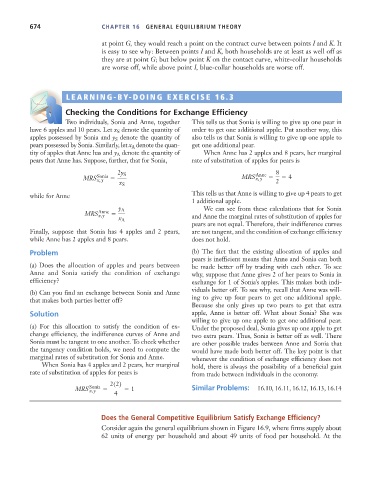Page 700 - Microeconomics, Fourth Edition
P. 700
c16GeneralEquilibriumTheory.qxd 8/16/10 9:14 PM Page 674
674 CHAPTER 16 GENERAL EQUILIBRIUM THEORY
at point G, they would reach a point on the contract curve between points I and K. It
is easy to see why: Between points I and K, both households are at least as well off as
they are at point G; but below point K on the contact curve, white-collar households
are worse off, while above point I, blue-collar households are worse off.
LEARNING-BY-DOING EXERCISE 16.3
S
D
E
Checking the Conditions for Exchange Efficiency
Two individuals, Sonia and Anne, together This tells us that Sonia is willing to give up one pear in
have 6 apples and 10 pears. Let x S denote the quantity of order to get one additional apple. Put another way, this
apples possessed by Sonia and y S denote the quantity of also tells us that Sonia is willing to give up one apple to
pears possessed by Sonia. Similarly, let x A denote the quan- get one additional pear.
tity of apples that Anne has and y A denote the quantity of When Anne has 2 apples and 8 pears, her marginal
pears that Anne has. Suppose, further, that for Sonia, rate of substitution of apples for pears is
8
2y S Anne
Sonia 4
MRS x, y MRS x, y 2
x S
while for Anne This tells us that Anne is willing to give up 4 pears to get
1 additional apple.
y A We can see from these calculations that for Sonia
Anne
MRS x, y and Anne the marginal rates of substitution of apples for
x A
pears are not equal. Therefore, their indifference curves
Finally, suppose that Sonia has 4 apples and 2 pears, are not tangent, and the condition of exchange efficiency
while Anne has 2 apples and 8 pears. does not hold.
Problem (b) The fact that the existing allocation of apples and
pears is inefficient means that Anne and Sonia can both
(a) Does the allocation of apples and pears between be made better off by trading with each other. To see
Anne and Sonia satisfy the condition of exchange why, suppose that Anne gives 2 of her pears to Sonia in
efficiency? exchange for 1 of Sonia’s apples. This makes both indi-
viduals better off. To see why, recall that Anne was will-
(b) Can you find an exchange between Sonia and Anne
that makes both parties better off? ing to give up four pears to get one additional apple.
Because she only gives up two pears to get that extra
Solution apple, Anne is better off. What about Sonia? She was
willing to give up one apple to get one additional pear.
(a) For this allocation to satisfy the condition of ex- Under the proposed deal, Sonia gives up one apple to get
change efficiency, the indifference curves of Anne and two extra pears. Thus, Sonia is better off as well. There
Sonia must be tangent to one another. To check whether are other possible trades between Anne and Sonia that
the tangency condition holds, we need to compute the would have made both better off. The key point is that
marginal rates of substitution for Sonia and Anne. whenever the condition of exchange efficiency does not
When Sonia has 4 apples and 2 pears, her marginal hold, there is always the possibility of a beneficial gain
rate of substitution of apples for pears is from trade between individuals in the economy.
2(2)
Sonia Similar Problems: 16.10, 16.11, 16.12, 16.13, 16.14
MRS x, y 1
4
Does the General Competitive Equilibrium Satisfy Exchange Efficiency?
Consider again the general equilibrium shown in Figure 16.9, where firms supply about
62 units of energy per household and about 49 units of food per household. At the

